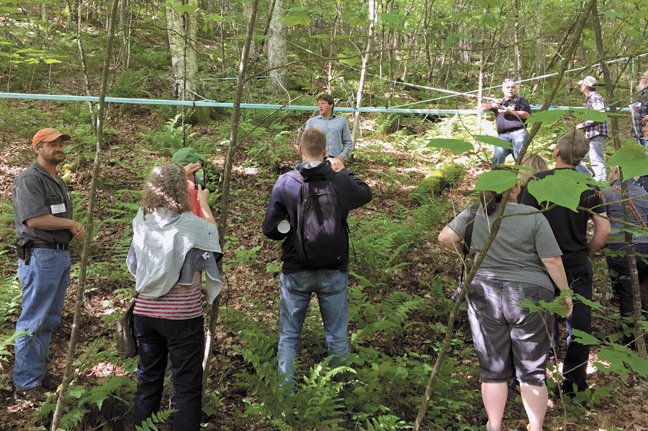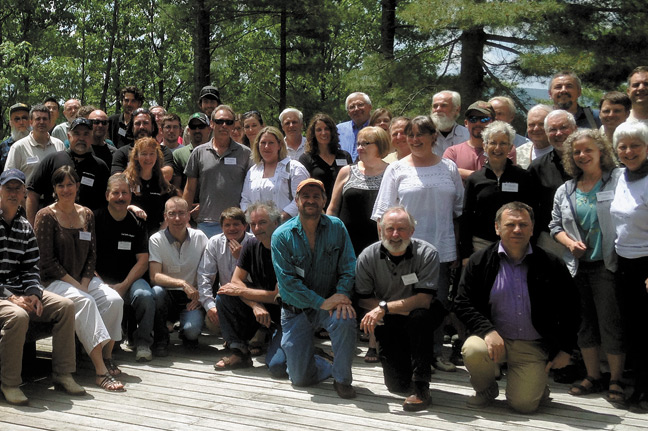Cornell Corner
First international birch conference a success
Birch sap and syrup producers from all over the world take part
By MICHAEL FARRELL |
This past June nearly 70 current and potential birch sap and syrup producers from all over the world got together for 3 days at Paul Smiths College in the heart of the Adirondacks to network and share information. The primary center for events was the Adirondack Center for Working Landscapes at the Paul Smiths VIC. The conference was a remarkable gathering with many new contacts made and lots of knowledge spread among the attendees. There were plenty of existing maple sugarmakers from the northeast who are already producing birch syrup or thinking of doing so along with birch sap and syrup producers from Alaska, nearly every Canadian province, eastern Europe, and Russia.
The conference kicked off on Friday evening with the Tastes of Birch event. Twenty-three producers brought some of their birch sap, syrup, or other birch-based products to sample among the entire group. In addition to a wide selection of birch syrups, other products included different flavors of birch water, birch beer, birch wine, birch caramels, birch bacon jam, birch BBQ sauce, and so on. Although many sugarmakers have preconceived notions that birch syrup and other birch products don’t taste very good, everyone who got a chance to try the various products that evening came away impressed with the wonderful diversity of flavors from the different producers. I was particularly amazed at the great flavors in almost all of the birch syrups that I tried.
There isn’t an established grading system for birch syrup at this time. The color and flavor of birch syrup changes throughout the course of the season in a similar manner to maple syrup, so many birch syrup producers classify their syrups in to first run, mid-run, and late run. Thus, we had three different categories of birch syrup as well as birch sap beverages and specialty birch products categories. When sampling, attendees were able to give a product a 1-10 rating (with 10 being the highest) and all of the scores were tabulated the next day.
Temple Tappers out of Maine and Kahiltna Gold from Alaska were the biggest winners in the competition, placing in the top 3 in all three categories. Millbrook Maples in the Catskills, Uncle Berwyn’s from the Yukon, and Bridge Creek from also ranked in the top 3 in one of the categories. The average scoring for the top 3 finishers in each category is seen below.
First-run
Temple Tappers 9.2
Kahiltna Gold 8.8
Millbrook 8.5
Mid-Run
Kahiltna Gold 9.0
Uncle Berwyn’s 8.9
Temple Tappers 8.5
Late Run
Bridge Creek 8.7
Temple Tappers 8.0
Kahiltna Gold 7.8
In the birch water category, Botanical Springs, a newly formed company from Massachusetts, took first and second place with their ‘Cucumber-Watermelon Birch Water’ (9.1) and pure Birch Water (8.0). The Bilberry & Lingonberry flavored Birch Water from Tapped came in third place with an average score of 7.1.
For the Specialty Birch Product category, the highest score went to the Birch Beer crafted by Raquette River Brewing in Tupper Lake. Their 9.5 average was the highest score of any product in the competition. The Birch Caramels from Kahiltna Gold (8.9) took second place while the
Canadian Birch Company’s Birch Bacon Jam (8.0) earned the bronze.
Saturday and Sunday provided a mixture of technical sessions, networking opportunities, and a tour of Cornell University’s Uihlein Forest, a center primarily devoted to maple syrup research and extension that has also gotten heavily involved with birch over the past few years.
On Saturday morning, following opening remarks from Paul Smith’s President Cathy Dove and VIC Director Brian McDonnell, John Zasada gave an overview of everything birch trees have to offer in his presentation entitled Celebrating Birch: A Minnesota Perspective. John is a retired US Forest Service research forester and spent many years working with all users of birch trees in North America- it was inspiring to hear all of the incredible products that come from “the giving tree”. I then presented an overview of the potential for birch syrup production in North America, highlighting the opportunities and challenges of incorporating birch syrup production in to an existing sugaring operation.
The remainder of the morning included several speakers from Alaska, including Jan Dawe and Valerie Barber from the University of Alaska Extension system and Dulce and Michael Ben-East from Kahiltna Birchworks. Jan and Val talked about the various programs and development of the birch sap and syrup industry in Alaska, in particular the focus on backyard operations. The Easts showed an incredible video of their operation and then talked about their 26 years in making and marketing birch syrup in Alaska. Abby Van den Berg and Mark Isselhardt provided an overview of their research at the Proctor Center, including sap yields and stem pressure physiology in birches as well as the internal compartmentalization of taphole wounds.
Maaria Kortesniemi provided an overview of the past, present and future research projects in birch syrup chemistry at the University of Turku in Finland. A roundtable discussion amongst all conference participants rounded out the day with interesting conversations on standards of identity for birch syrup and possible formation of an organization for birch similar to the IMSI and NAMSC for maple.
Everyone traveled over to Lake Placid on Sunday morning for a tour or Cornell University’s Uihlein Forest. We looked at the tubing system for birch, demonstrated installation of a new birch tubing system, and actually boiled down some birch sap in our 2 x 6 evaporator that had been frozen and then thawed for this event. Steve Caccamo from Next Generation Maple Products demonstrated concentration of the birch sap with reverse osmosis on one of the new ‘hobby-size’ 100 GPH units he had just produced.
On Sunday afternoon, Ihor Soloviy, a visiting fellow at UVM from Ukraine, gave a very interesting presentation on traditional and current uses of birch sap as a beverage in eastern Europe. Val Jerdes, founder of Byarozavik birch water, discussed the lessons learned from starting a birch water company and selling birch water in the U.S. Brent Lehouiller from Chippers discussed many of the details on the logistics of buying sap and leasing taps for people looking to expand their birch operations. Brett McLeod, a forestry professor at Paul Smiths College, rounded out the conference with an outside workshop on tips and tricks for tending the sugarbush, whether you are focused on maple or birch.
This was the first conference to ever bring together both academics and producers in the birch sap and syrup industry. It certainly won’t be the last. The group that came was very interested in having more conferences in the future and hopefully making this an annual event that rotates around the world wherever birches thrive. If you are a maple producer who has a large birch resource and have ever considered also tapping these trees, stay tuned for more developments and conferences in the future.
This conference was supported by the Northern NY Agricultural Development Program and the Cornell University Agricultural Experiment Station.
August/September 2015

































